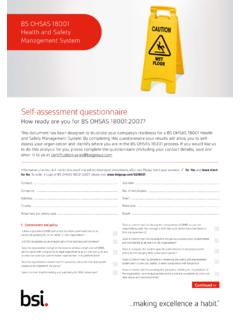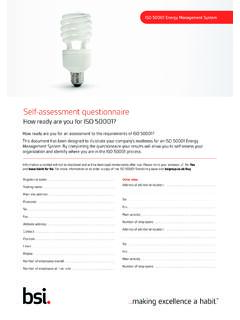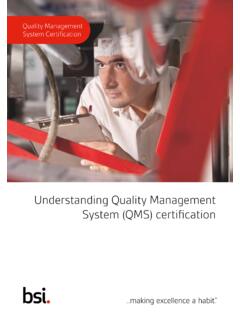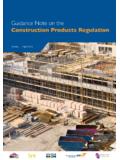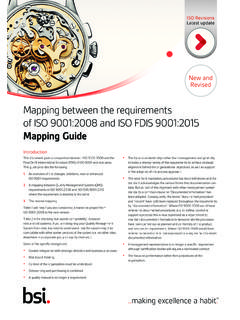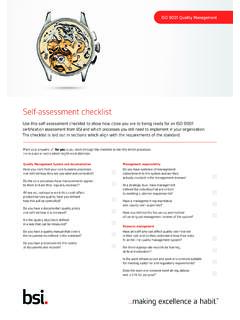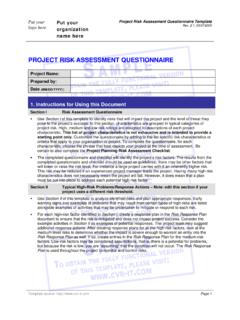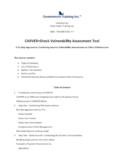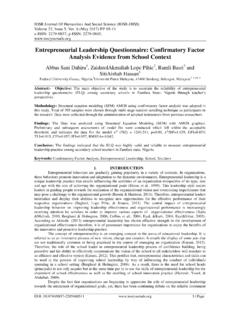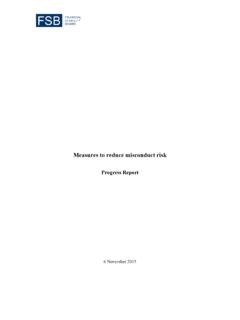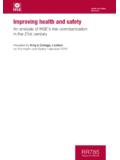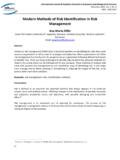Transcription of Self-assessment questionnaire - BSI Group
1 Self-assessment questionnaireHow ready are you for ISO 22301?This document has been designed to assess your company s readiness for an ISO 22301 Business Continuity Management System (BCMS). By completing this questionnaire your results will allow you to self -assess your organization and identify where you are in the ISO 22301 process. If you would like us to do this analysis for you, please complete the questionnaire (including your contact details), save and email it to us at Information provided will not be disclosed and will be destroyed immediately after use.
2 Please mark your answers for Yes and leave blank for No. To order a copy of ISO 22301 please visit : Job title: Company: No. of employees: Address: Town: County: Postcode: Telephone (inc. dialing code): Email: 1. The organization and its contextHave the issues that will drive the BCMS been defined? Has the environment within which the BCMS will operate (internal & external), and the expected outcomes of the system, been identified? Has an appropriate and repeatable risk assessment method and the acceptable levels of risk been defined and documented?
3 2. Needs and expectations of interested partiesIs the scope of the BCMS clear and documented? Is there a procedure in place to identify, take into account, document and maintain information on the applicable legal and regulatory requirements for the BCMS? Have these legal, regulatory and other requirements been communicated to affected employees and identified interested parties?Continued >>ISO 22301 Business Continuity Management System3. Scope of the BCMS Is the scope of the BCMS clear and documented? Have options for risk treatment been identified and evaluated?
4 Does the scope define the BCMS in terms of its extent, purpose, deliverables, needs and expectations in a way that is appropriate to the organization? Is there any exclusion from scope, and if so is it in an area that will not affect the organization s ability to provide continuity of operations? 4. Leadership and management commitmentIs the organization s leadership commitment to BCM visible and repeated? Is there a policy, programme and roles to evidence top management commitment to the BCMS? Has top management been appropriately involved in the BCMS implementation and review through a formal management review process?
5 5. Business Continuity Management (BCM) policyIs there an established BCM policy that is appropriate, maintained, communicated, and documented? Is the policy available to employees and all interested parties identified?6. Risks and opportunities of BCMS implementationHas an analysis of the threats and opportunities that may impact the implementation of the BCMS been conducted? Has a plan to manage the risks and opportunities of the BCMS implementation been developed and actioned? 7. Business continuity objectivesHave measurable business continuity (BC) objectives been established, documented and communicated throughout the organization?
6 Is the achievement of these objectives evaluated by both internal audit and the management review?8. BCMS resources and competenceAre roles within the BCMS clearly defined? Is the BCMS adequately resourced? Is there a process defined and documented for determining competence for BCMS roles?Are those undertaking BC roles competent, and is this competence documented appropriately? 9. Awareness and communicationIs everyone within the organization s control aware of the importance of the BCM policy, their involvement in implementing it and their role in a disruption?
7 Has a communication needs analysis been conducted for the BCMS? Have procedures been confirmed and facilities made available for communicating incidents? Are they regularly tested with results recorded? Is appropriate documentation created, maintained and controlled to demonstrate the effectiveness of the BCMS? 10. Operational planning and controlHave you devised and implemented a programme to ensure the BCMS achieves its outcomes?Has there been analysis of the threats to any outsourced processes and their impact on achieving BCMS and recovery time objectives?
8 11. Business Impact Analysis (BIA) Is there a formal and documented process for understanding the organization through a BIA? Is there a formal process for determining continuity objectives based on understanding the impact of disruptive incidents? Does the BIA enable prioritization of time frames for resuming each activity (Recovery Time Objectives)? Have minimum acceptable levels for resuming activities been identified?12. Risk assessment and treatmentIs there a formal risk assessment process for analysing the risk of disruptive incidents?
9 Does this risk assessment method identify risk treatments appropriate to BC objectives? Is there evidence of prioritizing risk treatments with costs identified?13. Business continuity strategyIs the BC strategy based on the outputs of the BIA and risk assessment ? Does the BC strategy protect prioritized activities and provide appropriate continuity and recovery of them, their dependencies and resources? Does the BC strategy provide for mitigating, responding to and managing impacts? Have prioritized time frames been set for the resumption of all activities?
10 Have the BC capabilities of suppliers been evaluated? Have the resource requirements for the selected strategy options been determined, including people, information and data, infrastructure, facilities, consumables, IT, transport, finance and partner/supplier services? Have measures to reduce the likelihood, duration or impact of a disruption for identified risks been considered and implemented, and are these in accordance with the organization s risk appetite?14. Establishing and implementing BC proceduresHave BC procedures been put in place to manage a disruptive incident, and have continuity activities based on recovery objectives been identified in the BIA?
